国际经济学作业答案-第五章
- 格式:doc
- 大小:1.48 MB
- 文档页数:13
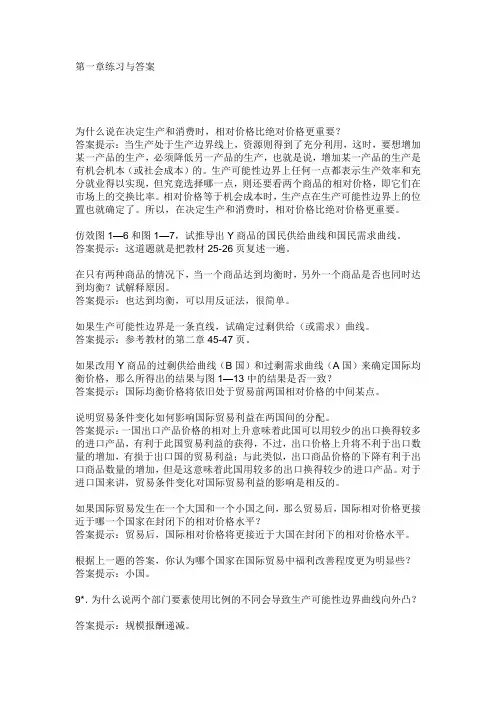
第一章练习与答案为什么说在决定生产和消费时,相对价格比绝对价格更重要?答案提示:当生产处于生产边界线上,资源则得到了充分利用,这时,要想增加某一产品的生产,必须降低另一产品的生产,也就是说,增加某一产品的生产是有机会机本(或社会成本)的。
生产可能性边界上任何一点都表示生产效率和充分就业得以实现,但究竟选择哪一点,则还要看两个商品的相对价格,即它们在市场上的交换比率。
相对价格等于机会成本时,生产点在生产可能性边界上的位置也就确定了。
所以,在决定生产和消费时,相对价格比绝对价格更重要。
仿效图1—6和图1—7,试推导出Y商品的国民供给曲线和国民需求曲线。
答案提示:这道题就是把教材25-26页复述一遍。
在只有两种商品的情况下,当一个商品达到均衡时,另外一个商品是否也同时达到均衡?试解释原因。
答案提示:也达到均衡,可以用反证法,很简单。
如果生产可能性边界是一条直线,试确定过剩供给(或需求)曲线。
答案提示:参考教材的第二章45-47页。
如果改用Y商品的过剩供给曲线(B国)和过剩需求曲线(A国)来确定国际均衡价格,那么所得出的结果与图1—13中的结果是否一致?答案提示:国际均衡价格将依旧处于贸易前两国相对价格的中间某点。
说明贸易条件变化如何影响国际贸易利益在两国间的分配。
答案提示:一国出口产品价格的相对上升意味着此国可以用较少的出口换得较多的进口产品,有利于此国贸易利益的获得,不过,出口价格上升将不利于出口数量的增加,有损于出口国的贸易利益;与此类似,出口商品价格的下降有利于出口商品数量的增加,但是这意味着此国用较多的出口换得较少的进口产品。
对于进口国来讲,贸易条件变化对国际贸易利益的影响是相反的。
如果国际贸易发生在一个大国和一个小国之间,那么贸易后,国际相对价格更接近于哪一个国家在封闭下的相对价格水平?答案提示:贸易后,国际相对价格将更接近于大国在封闭下的相对价格水平。
根据上一题的答案,你认为哪个国家在国际贸易中福利改善程度更为明显些?答案提示:小国。
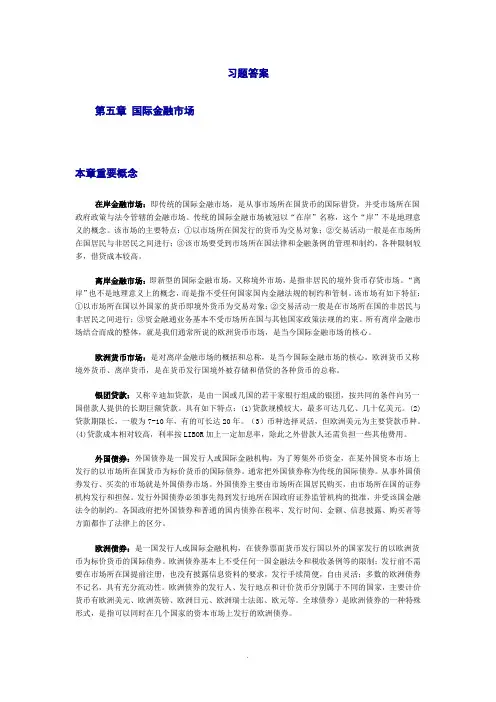
习题答案第五章国际金融市场本章重要概念在岸金融市场:即传统的国际金融市场,是从事市场所在国货币的国际借贷,并受市场所在国政府政策与法令管辖的金融市场。
传统的国际金融市场被冠以“在岸”名称,这个“岸”不是地理意义的概念。
该市场的主要特点:①以市场所在国发行的货币为交易对象;②交易活动一般是在市场所在国居民与非居民之间进行;③该市场要受到市场所在国法律和金融条例的管理和制约,各种限制较多,借贷成本较高。
离岸金融市场:即新型的国际金融市场,又称境外市场,是指非居民的境外货币存贷市场。
“离岸”也不是地理意义上的概念,而是指不受任何国家国内金融法规的制约和管制。
该市场有如下特征:①以市场所在国以外国家的货币即境外货币为交易对象;②交易活动一般是在市场所在国的非居民与非居民之间进行;③资金融通业务基本不受市场所在国与其他国家政策法规的约束。
所有离岸金融市场结合而成的整体,就是我们通常所说的欧洲货币市场,是当今国际金融市场的核心。
欧洲货币市场:是对离岸金融市场的概括和总称,是当今国际金融市场的核心。
欧洲货币又称境外货币、离岸货币,是在货币发行国境外被存储和借贷的各种货币的总称。
银团贷款:又称辛迪加贷款,是由一国或几国的若干家银行组成的银团,按共同的条件向另一国借款人提供的长期巨额贷款。
具有如下特点:(1)贷款规模较大,最多可达几亿、几十亿美元。
(2)贷款期限长,一般为7-10年,有的可长达20年。
(3)币种选择灵活,但欧洲美元为主要贷款币种。
(4)贷款成本相对较高,利率按LIBOR加上一定加息率,除此之外借款人还需负担一些其他费用。
外国债券:外国债券是一国发行人或国际金融机构,为了筹集外币资金,在某外国资本市场上发行的以市场所在国货币为标价货币的国际债券。
通常把外国债券称为传统的国际债券。
从事外国债券发行、买卖的市场就是外国债券市场。
外国债券主要由市场所在国居民购买,由市场所在国的证券机构发行和担保。
发行外国债券必须事先得到发行地所在国政府证券监管机构的批准,并受该国金融法令的制约。

第一章国际贸易理论的微观基础1.为什么说在决定生产和消费时,相对价格比绝对价格更重要?答案提示:当生产处于生产边界线上,资源则得到了充分利用,这时,要想增加某一产品的生产,必须降低另一产品的生产,也就是说,增加某一产品的生产是有机会机本(或社会成本)的。
生产可能性边界上任何一点都表示生产效率和充分就业得以实现,但究竟选择哪一点,则还要看两个商品的相对价格,即它们在市场上的交换比率。
相对价格等于机会成本时,生产点在生产可能性边界上的位置也就确定了。
所以,在决定生产和消费时,相对价格比绝对价格更重要。
2.仿效图1—6和图1—7,试推导出Y商品的国民供给曲线和国民需求曲线。
答案提示:参照教材中第一章第二节(第26页)的内容,将图1-6(a)中,以横坐标表示Y商品的供给,以纵坐标表示X商品供给,得出相应的生产可能性曲线;然后将图1-6(b)中,以横坐标表示Y商品的供给,以纵坐标表示Y的相对价格P Y/P X,通过类似推导可得出国民供给曲线,国民需求曲线做类似推导即可求出。
3.在只有两种商品的情况下,当一个商品达到均衡时,另外一个商品是否也同时达到均衡?试解释原因。
答案提示:两种商品同时达到均衡。
当一种商品达到均衡时,该商品的相对价格、均衡供给与需求、均衡状态下对生产要素的需求与供给都得以确定,则可得到另一种商品的相对价格、生产要素需求,从而确定该商品的均衡状态下供给和需求。
4.如果生产可能性边界是一条直线,试确定过剩供给(或需求)曲线。
答案提示:参照教材图1-12、图1-13国民供给曲线与国民需求曲线的推导;过剩供给(或需求)曲线的形状,参见教材第30页。
5.如果改用Y商品的过剩供给曲线(B国)和过剩需求曲线(A国)来确定国际均衡价格,那么所得出的结果与图1—13中的结果是否一致?答案提示:相一致。
国际均衡价格将依旧处于贸易前两国相对价格的中间某点。
6.说明贸易条件变化如何影响国际贸易利益在两国间的分配。
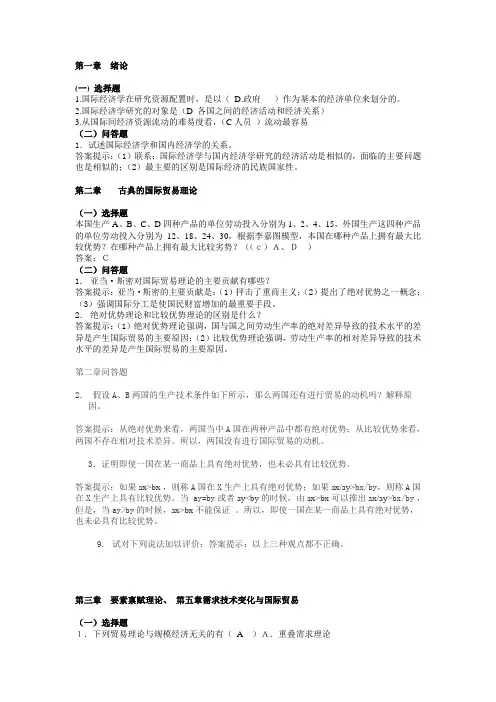
第一章绪论(一) 选择题1.国际经济学在研究资源配置时,是以(D.政府)作为基本的经济单位来划分的。
2.国际经济学研究的对象是(D 各国之间的经济活动和经济关系)3.从国际间经济资源流动的难易度看,(C人员)流动最容易(二)问答题1.试述国际经济学和国内经济学的关系。
答案提示:(1)联系:国际经济学与国内经济学研究的经济活动是相似的,面临的主要问题也是相似的;(2)最主要的区别是国际经济的民族国家性。
第二章古典的国际贸易理论(一)选择题本国生产A、B、C、D四种产品的单位劳动投入分别为1、2、4、15,外国生产这四种产品的单位劳动投入分别为12、18、24、30,根据李嘉图模型,本国在哪种产品上拥有最大比较优势?在哪种产品上拥有最大比较劣势?((c)A、D)答案:C(二)问答题1.亚当·斯密对国际贸易理论的主要贡献有哪些?答案提示:亚当·斯密的主要贡献是:(1)抨击了重商主义;(2)提出了绝对优势之一概念;(3)强调国际分工是使国民财富增加的最重要手段。
2.绝对优势理论和比较优势理论的区别是什么?答案提示:(1)绝对优势理论强调,国与国之间劳动生产率的绝对差异导致的技术水平的差异是产生国际贸易的主要原因;(2)比较优势理论强调,劳动生产率的相对差异导致的技术水平的差异是产生国际贸易的主要原因。
第二章问答题2.假设A、B两国的生产技术条件如下所示,那么两国还有进行贸易的动机吗?解释原因。
答案提示:从绝对优势来看,两国当中A国在两种产品中都有绝对优势;从比较优势来看,两国不存在相对技术差异。
所以,两国没有进行国际贸易的动机。
3.证明即使一国在某一商品上具有绝对优势,也未必具有比较优势。
答案提示:如果ax>bx,则称A国在X生产上具有绝对优势;如果ax/ay>bx/by,则称A国在X生产上具有比较优势。
当 ay=by或者ay<by的时候,由ax>bx可以推出ax/ay>bx/by,但是,当ay>by的时候,ax>bx不能保证。
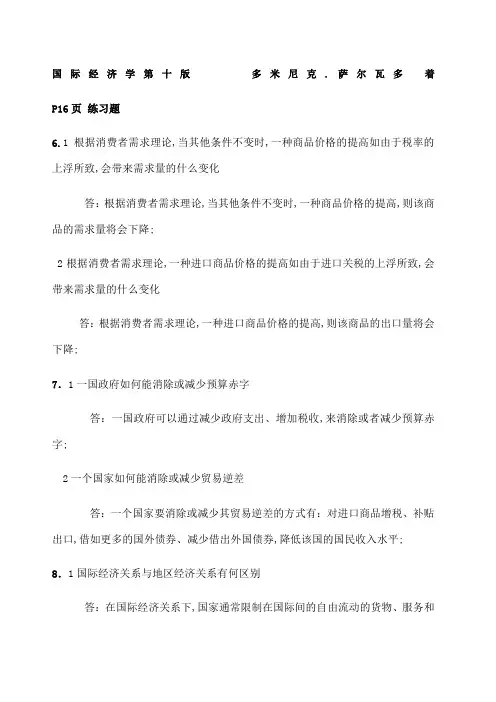
国际经济学第十版多米尼克.萨尔瓦多着P16页练习题6.1根据消费者需求理论,当其他条件不变时,一种商品价格的提高如由于税率的上浮所致,会带来需求量的什么变化答:根据消费者需求理论,当其他条件不变时,一种商品价格的提高,则该商品的需求量将会下降;2根据消费者需求理论,一种进口商品价格的提高如由于进口关税的上浮所致,会带来需求量的什么变化答:根据消费者需求理论,一种进口商品价格的提高,则该商品的出口量将会下降;7.1一国政府如何能消除或减少预算赤字答:一国政府可以通过减少政府支出、增加税收,来消除或者减少预算赤字;2一个国家如何能消除或减少贸易逆差答:一个国家要消除或减少其贸易逆差的方式有:对进口商品增税、补贴出口,借如更多的国外债券、减少借出外国债券,降低该国的国民收入水平; 8.1国际经济关系与地区经济关系有何区别答:在国际经济关系下,国家通常限制在国际间的自由流动的货物、服务和因素,不同的语言、消费习惯和法律规定同样也阻碍了它们在国际间的流动,此外,国际收支会在各种货币收据和付款中流通;而在地区经济关系下,就关税和进行相同的货币而言,区际流动的货物、服务和因素没有面临这样的限制因素,它们经常是在同样的语言环境下,在类似的消费习惯和法律规定下进行的,这就与国际经济关系形成了鲜明对比;2它们在哪方面相似答:国际经济关系和地区经济关系的相似点:两者都跨越了空间距离,事实上,它们都是在远距离贸易下的产物,把经济看待成在一个进行着生产、交换和消费的空间中的单一点,这也是从经济学的复位空间将它们区分;10.如果说一个国家可以从国际贸易中获益,那么你如何解释为什么许多国家又要对国际贸易施加某些限制答:国际贸易给本国消费者带来的是更低的价格,这样就会对本国的同种商品的生产商造成不利,挤兑了本国生产商的销售份额;通常在这种情况下,本国的生产商就会失去大量的订单,并且向政府提议限制进口;而由于消费者很多,平均每个消费者只有非常小的进口商品利益,政府就会根据生产商的要求,施加一些进口限制;第二章比较优势原理P45页练习题1.表列出了在4中假定下,英美两国1劳动小时可生产的小麦与布匹的数量;支出每种情况下,美、英两国具有绝对优势或劣势的商品;答:在A情形下,美国具有绝对优势的商品是小麦;英国具有绝对优势的商品是布匹;在B情形下,美国在小麦和布匹都有绝对优势;在C情形下,美国在小麦和布匹生产商都具有绝对优势,而英国在这两种商品的生产中都不具有绝对优势;在D情形下,美国在小麦、布匹这两种商品具有的绝对优势都比英国明显;2.指出表中每个国家有比较优势与比较劣势的商品;答:在A情形下,美国具有相对优势的商品是小麦;英国在布匹生产上具有相对优势;在B情形下,美国在小麦具有相对优势;英国在布匹生产具有相对优势;在C情形下,美国在小麦具有相对优势;英国在布匹生产具有相对优势;在D情形下,美国、英国在小麦、布匹这两种商品生产上没有相对优势; 3.指出表中每种情况下,贸易的可能性贸易基础;答:在A情形下,贸易的可能性贸易基础是绝对优势;在B情形下,贸易的可能性贸易基础是相对优势;在C情形下,贸易的可能性贸易基础是相对优势;在D情形下,没有贸易的可能性,因为美国在这两种商品的生产上都比英国具有绝对优势;4. 假设在表中的B 情况下,美国用4单位小麦与英国用的4单位布交换: (1) 美国获利多少 (2) 英国获利多少(3) 互惠贸易的范围有多大(4) 如果改用4单位小麦与6单位布交换,两国分别获利多少 答:1美国获利1C 2英国获利3C 3 3C<4W<8C4美国获利3C,而英国获利1w;5. 表中的B 情况下,假设劳动是唯一生产要素而且是同质的即只有一种类型: (1) 用劳动测度,美、英两国生产小麦和布的成本是多少 (2) 如果工资率为6美元,则小麦和布在美国的价格是多少 (3) 如果工资率为1英镑,则小麦和布在英国的价格是多少答:1在劳动测度下,生产小麦的成本在美国是1/4,在英国为1;而生产布匹的成本在美国是1/3,在英国为1/2.2在美国,小麦的价格w P =美元,而布匹的价格c P =美元; 3在英国,小麦的价格w P =英镑,而布匹的价格c P =英镑;6. 参考第5题回答:(1) 若美元、英镑的外汇比价是1英镑=2美元,则小麦与布在英国的美元价格是多少在此汇率下,美国会想英国出口小麦吗在此汇率下,英国会想美国出口布吗(2) 当汇率是1英镑=4美元时情况如何 (3) 当汇率是1英镑=1美元时又如何(4) 允许美国向英国出口小麦和允许英国向美国出口布的汇率范围是多少 答:1在英国,当美元、英镑的外汇比价是1英镑=2美元时,美国会出口小麦到英国,而英国会出口布匹到美国;2当汇率是1英镑=4美元时,在英国:$4.00w P =,$2.00c P =,因此美国会出口小麦到英国,而英国不会出口布匹到美国;3当汇率是1英镑=1美元时,在英国,$1.00,$0.50w c P P ==,因此英国会都出口小麦、布匹这两种商品到美国;4$1.50£1.00$4.00<< 7. 假设表中B 情形的数据单位是百万蒲尔式小麦和百万码布: (1) 画出英美两国的生产可能线(2) 美、英两国的小麦相对价格为多少即c /w P P (3) 美、英两国的布匹相对价格为多少即/c w P P答:12小麦相对价格:在美国,w /3/4c P P =,在英国w /2c P P =; 3布匹相对价格:在美国,w /4/3c P P =,在英国w /1/2c P P =; 9.1如果图左图中的w()US UK D +向上移1/3,则小麦的均衡价格是多少此时,美、英国生产多少单位小麦和布21中的答案对右图的()c US UK D +意味着什么答:1此时小麦的均衡价格会从1/3上升到w /4/3c P P =;因为更高的w()US UK D +会和()W US UK S +曲线交叉,美国会继续专门生产小麦180W,而英国会继续专门生产布匹120C.2由于布匹的均衡价格是小麦的均衡价格的倒数,所以如果小麦的均衡价格是4/3,则布匹的均衡价格是3/4.这就意味着图中右图的()C US UKD +将会向右下移1/3;11.画一张与图类似的图,表明英国现在是一个小国,为图中右图所示的一半,并在c /w P P =2/3时用20单位布与美国的30单位小麦交换;第三章 国际贸易的标准理论P66页 练习题1. 在一个坐标系中,画一条凹向原点的生产可能性曲线(1) 从生产可能性曲线的中点开始,用箭头表示该国在生产更多X 纵轴表示的商品和更多Y 时所发生的机会成本递增情况;(2) 当生产更多的X 时,生产可能性曲线的斜率如何变化生产更多的Y 呢这种变化反映了什么答:12当生产更多的X时,则Y 的产量将减少,生产可能性曲线的斜率会增大;当生产更多的Y时,X的产量也会减少;这种变化反映了随着生产更多的X或者Y,机会成本是递增的,即:一个国家每多生产以单位该种商品,就必须放弃越来越多的另一种商品的生产以提高足够的资源;2.在另一个坐标系中,画出三条社会无差异曲线,并令最高两条相交:(1)社会无差异曲线为什么向下倾斜,或者说斜率为负(2)曲线的斜率代表什么为什么每条无差异曲线在较低点斜率较小呢(3)考虑相交的两条无差异曲线,在交点右边的那一条曲线表示的满意程度较高吗在交点左边呢为什么和无差异曲线的定义不一致你可以得出什么结论答:1社会无差异曲线向下倾斜是因为:在无差异曲线上,当消费者购买更多的X时,他们会放弃部分Y;2曲线的斜率代表社会或国家在获得相同的满足程度下,多消费一单位X的同时,必须减少Y 的消费量;无差异曲线在较低点斜率较小是因为:随着X的增大,Y减小,则从一单位的X得到的满足程度降低,而从一单位Y所得到的满足程度将增大; 3当在交点在右边时,满意程度:C>B;当交点在左边是:B>C;这种不一致是因为无差异曲线反映的是一个给定的满足程度的两种商品的不同组合,因此无差异曲线不能相交;、而一组特定的无差异曲线拜师的是一国国内一种特定的收入分配,一种不同的收入分配会导致一组全新的无差异曲线,而它很可能与先前的无差异曲线相交;例如一国开始贸易或扩大外贸规模时,无差异曲线的相交就会发生;3.在一个坐标系内,画一条生产可能性曲线,再画一条无差异曲线切于生产可能性曲线较平坦的地方;在另一个坐标系内,画另一条生产可能性曲线,再画另一条无差异曲线切于生产可能性曲线较陡直的地方;(1)画一条表示各国在孤立情形下的均衡想多商品价格的直线;(2)各国具有比较优势的商品分别是什么(3)在什么情况下,两国之间不存在比较优势或比较劣势答:12国家1在商品X上具有比较优势,而国家2在Y商品具有比较优势;3当两国的这两种商品的相对价格线具有相同的斜率时,两国不存在比较优势; 4.1在第3题图中,用箭头表示在贸易条件下各国专业化生产的方向,标出各国均衡的产量和消费2各国相对自给自足状态有什么额外所得哪个国家所得更多为什么答:12对于国家1,在E点到A点的右上方获利,而国家2从E'超过A'获利;国家1将从贸易中获得额外所得,因为X的相对价格比贸易前差别更大;5.在一个坐标系内,画出国家1对于X 的出口供给曲线,/X Y P P =1/4,X 的共给量X QS =0;/X Y P P =1/2时,X QS =40;/X Y P P =1时,X QS =60;/X Y P P =112时,X QS =70.在同一坐标系内,画出国家2对于国家1出口商品X 的需求曲线;/X Y P P =112时,对X 的需求X QD =40; /X Y P P =1时, X QD =60; /X Y P P =1/2时, X QD =120. 1确定出口X 的贸易均衡的相对商品价格;2如果/X Y P P =112,会发生什么3如果/X Y P P =1/2,又会发生什么 答:1S 是国家1的出口商品X 的供给曲线,而D 是国家2的出口商品X 的需求曲线,而需求和供给曲线在E 点相交,决定了X 的出口贸易均衡的相对价格为/B X Y P P P ==1,和均衡出口量是60X;2如果/X Y P P =112,将出现一个30R R X '=的出口供给过剩,而相对价格/X Y P P 将会降低至/X Y P P =1.(3) 如果/X Y P P =1/2,将出现一个80H HX '=的出口需求过剩,而相对价格/X Y P P 会升至/X Y P P =1.7.在一坐标系内,画一条凹向原点的生产可能性曲线,再画一条社会无差异曲线与其相切于平坦的部分;标出该国在自给自足状态下的均衡相对商品价格,记为A P ,假设该曲线表示一个小国,其对贸易并不影响世界市场的相对价格W P ,在图上标出分工的过程、贸易量和贸易所得;答:该小国的生产会从A点移动到B点,出口商品X来交换商品Y以达到最佳点E>A;9.在两个坐标系中,画两条相同的凹向原点的生产可能性曲线;再画两条分别与其相切的社会无差异曲线;1指出各国自给自足状态下的均衡相对价格;2指出生产分工的过程及互利贸易的过程;答:1211.在固定成本条件下,如果生产可能性曲线相同而无差异曲线不同,会发生什么情况画一条曲线来表示这种情况;答:在固定成本条件下,如果生产可能性曲线相同而无差异曲线不同,但持续的机会成本,使这两个国家之间不存在互利贸易的可能;第一章供给、需求、提供曲线与贸易条件P87页练习题5.一国的提供曲线与下列曲线有哪些相似之处1需求曲线 2供给曲线 3提供曲线与普通的需求曲线和供给曲线有哪些差异答:1一国的提供曲线与需求曲线的相似之处是它们都表示一国的进口需求;2一国的提供曲线与供给曲线的相似之处是它们都表示一国的出口供给;3提供曲反映的是一国为了进口其需要的某一数量的商品而愿意出口的商品的数量;而普通的需求曲线和供给曲线反映的是供给和需求的相对数量;7.为了说明两国如何不平均分配贸易所得:(1) 画一幅图,一国的提供曲线的曲率远大于其贸易伙伴国提供曲线的曲率;(2) 哪个国家在贸易中获益更大(3) 解释原因答:12提供曲线的斜率越大,则该国家获利越大;3提供曲线越大的国家越能从贸易中获利,这是因为斜率越大,该提供曲线反映的国家对外国出口商品的需求越弱;8..从图中左图推导国家2对于商品Y 的出口供给曲线;从图的左图推导国家1对于国家2出口商品Y 的供给曲线与需求曲线;用你所得到的供给曲线与需求曲线表示如何确定Y 的贸易均衡相对价格;答:从教材图的左图可以看出,在/=4X Y P P 的相对价格下,国家2并没有出口任何数量的商品Y,令为国家2出口商品Y 的供给曲线S 上的A 点,同时也可知,/X Y P P =2是,国家2出口40单位的Y,得到S 曲线上的H 点;从教材左图,在//X Y Y X P P P P =1时,国家1需要国家2出口60单位的Y,这就在国家1的需求曲线D 上找到了点E,我们还可以估计国家1在/Y X P P =3/2时D 曲线上的H 点,需要40单位的Y,在/Y X P P =2时D 曲线上的H '点,需要120单位的Y;商品Y 的相对均衡价格是/Y X P P =1,这就决定了D 曲线的交点;在/Y X P P =3/2时,存在一个过度供给R R '=30Y 且/Y X P P 降至/Y X P P =1.在/Y X P P =1/2时,则存在=1个过度需求H H '=80Y,且/Y X P P 升至/Y X P P =1;9.1为什么第8题所使用的是局部均衡分析2为什么图的分析是一般均衡分析3局部均衡分析和一般均衡分析之间有什么关系答:1原因:利用传统的供给需求曲线,这两种曲线涉及到从经济体中所有的与商品Y 相关联的其他市场相分离,这只是对这个问题探索的大概分析;2图的分析是建立在提供曲线的基础上的;这些联系是发生在这两个国家的这两种商品的需求、供给里的,因此才能从每个国家、每种商品的供给和需求方面分别分析;这中分析法对这个问题的解释将比局部均衡分析更为全面、清晰,也更复杂;10.绘制国家1和国家2的提供曲线,国家2是一个小国,在国家1的贸易前的相对商品价格水平上进行贸易,贸易所得在两国之间如何分配为什么答:贸易在两国之间的分配:由于国家2是一个小国,在原点附近放大国家1的部分,意味着国家2可以进口充分小的商品X 就可以影响到国家1 的相对价格/X Y P P ,因此国家2是一个价格决定者;只要国家1维持不变的机会成本,且不是专门生产商品X,则在贸易中国家2将获得所有的利益,即使国家2不是一个小国,结果也是一样的; 11.画一幅图表示两个生产机会成本不变的国家的贸易均衡点;答:两国都的机会成不变,这是不可能的事件;两国的提供曲线都是直线直到两国在产品上完全专门化生产;之后,提供曲线会以正常形状相交于E点,并在E点得到相对价格/=P P P;X Y E12.假设在某一时间内,一国的贸易条件由100增长至110:1该国贸易伙伴国的贸易条件恶化了多少2从什么角度可以说贸易伙伴国由于这个变化,其贸易状况发生了恶化能认为贸易伙伴国的社会福利一定降低了吗答:1在某一时间内,一国的贸易条件由100增长至110,则该国贸易伙伴的贸易条件恶化了9%;2贸易国的贸易条件恶化了,则其贸易伙伴国必须为该国的商品进口支付更高的价格;而这并不意味着贸易伙伴国的社会福利一定降低了,因为这时期的贸易恶化可能是由于生产力比其他国家增加的更高效;第二章要素禀赋与赫克歇尔—俄林理论P123页练习题1.画两个坐标系分别表示国家1和国家2,横轴代表劳动,纵轴代表资本;(1)用通过远点的直线表示前两国生产Y时的资本/劳动比率高于生产X时的这一比率,以及国家2生产两种商品时的资本/劳动比率均高于国家1生产相应商品时的这一比率;(2)在国际贸易条件下,当国家2的利率/工资比率上升时,表示国家2每一种上平的资本/劳动比率的直线的斜率如何变化(3)在国际贸易条件下,当国家1的利率/工资比率下降时,表示国家1的资本/劳动比率的直线的斜率如何变化(4)根据2和3的结果说明,与贸易前的情况相比,国际贸易叩打还是缩小了两国生产每一商品的资本/劳动比率的差异呢答:12国家2的每一种商品的资本/劳动比率会下降;3国家1的每一种商品的资本/劳动比率会上升;4国际贸易缩小了两国生产每一种商品的资本/劳动比率差异;2.1画出与相似的图,说明在自给自足的条件下各国的均衡点以及贸易条件下各国的生产和消费点2解释是什么因素决定了两国的比较优势3为什么在无贸易条件下,两国消费两种商品的数量不同而在贸易条件下,两国消费两种商品的数量相同答:12在相同生产条件下的差异决定了两国的比较优势3因为无贸易条件下,两国的同种商品分别在本国的价格不同,因此其消费数量也不同;但是一旦有了贸易,则价格就相同了,因此消费两种商品的数量也相同;6.要素禀赋的差异会使两国的生产可能性曲线的形状产生不同:1还有什么其他因素会导致两国的生产可能性曲线有不同的形状2在赫—俄模型中,赫克歇尔和俄林做了哪些假设来防止1中的情形发生3在无贸易条件下,还有什么其他可能的原因会导致两国的相对商品价格产生差异答:1生产前沿也会导致两国的生产可能性曲线有不同形状;2为了防止要素禀赋的差异会使两国的生产可能性曲线的形状产生不同,赫克歇尔和俄林假设:两国的生产前沿不同是因为这两国的技术水平不同;3在无贸易条件下,导致两国的相对商品价格产生差异的其他可能原因有:两国的相关商品的价格不同;7.在两国需求偏好不同的条件下,作与图相似的直线,表明赫克歇尔—俄林模型仍然使用;答:12.1讨论里昂惕夫之谜的含义和重要意义;2概括说明克拉维斯、基辛、肯恩、鲍德温利用人力资本解决里昂惕夫之谜的经验检验的结果;3利墨尔、斯特恩、马斯库斯、萨瓦尔多和巴拉扎什是如何解释里昂惕夫之谜的答:1里昂惕夫之谜的含义:里昂惕夫用1947年美国数据对赫克歇尔—俄林模型做了第一个经验性检验;发现美国进口替代品的资本密集程度比美国出口商品的资本密集程度高出大约30%,由于美国是世界是上资本最密集的国家,这意味着美国进口的是资本密集型商品,出口的反而市劳动密集型商品;这与赫—俄理论的预测完全相反;里昂惕夫之谜的意义:里昂惕夫对赫——俄学说的验证,不仅开创了用投入——产出法这类经验手段检验理论假说的先河,大大推动了国际贸易的实证研究,而且第一个指明该理论学说与事实相悖逆,从而促进了战后各种各样贸易理论和见解的涌现;可见,里昂惕夫之谜的发现已成为战后国际贸易发展的基石;对该谜的种种解释,也没有从根本上否定赫——俄学说,而只是试图改变该学说的某些理论前提以适用实际情况;这表明,比较利益说仍是这些理论解释的内核;2科维拉斯得出正确结论:美国出口行业的高工资反映了美国出口行业比美国进口替代行业有较高的劳动生产率和较多的人力资本;肯恩实际估计了美国进出口竞争商品中人力资本的含量,并把其加载实物资本需求之上重新计算美国出口和进口替代品的资本/劳动比率;发现,利用%的收益率时比较保守估计,并不能彻底消除里昂惕夫悖论;但是,利用9%的收益率时,则可以完全消除里昂惕夫悖论,于是成功解释和消除了里昂惕夫之谜;1987年,鲍恩、利墨尔、思威考斯卡斯使用27个国家12种要素资源和多种商品的更完整的1967年贸易、要素投入需求和要素禀赋的剖面数据进行考察,发现赫克歇尔—俄林贸易模型只在部分情况下成立;3利墨尔、斯特恩、马斯库斯、萨瓦尔多和巴拉扎什对里昂惕夫之谜的解释方式是:由于美国劳动不必外国劳动含有更多的人力资本,把人力资本这一部分加到实物资本上就会使美国的出口相对于进口替代品的资本密集程度要大,从而解释了里昂惕夫之谜;14.解释为何在存在要素密集度颠倒的条件下,资本价格的世界性差异会缩小、上升、不变;答:要素密集度颠倒是指:一种给定商品在劳动丰裕的国家是劳动密集型产品,在资本密集型国家是资本密集型产品;例如:如果商品X在国家1低工资国家是劳动密集型商品,同时在国家2高工资国家是资本密集型产品,要素密集度的颠倒就发生了;要素密集度颠倒一旦发生了,则H—O理论和要素价格均等理论不再成立;原因是:国家1分工生产商品X,从而需要更多的劳动,国家1的相对和绝对工资就会上升;另一方面,由于国家2不能像国家1出口X,它就不得不分工生产和出口商品Y,而在国家2,Y是相对劳动密集的商品,故国家2对劳动需求以及工资也会上升,两国相对工资和绝对工资之间的差异如何变化取决于各国工资上涨的快慢程度;在贸易条件下,两国的相对和绝对工资差异会缩小、扩大或保持不变,要素价格均等理论不成立;第三章规模经济、不完全竞争与国际贸易P157 练习题1.画一张与相似的图,表示在规模经济下,生产可能性曲线相同而偏好不同的国家之间是如何进行互利贸易的答:2.如果两国生产可能性曲线不同,需求不同,其他条件同上题,重做第1 题;答:3.如果两国生产可能性曲线及偏好均不同,需求不同,其他条件同上题,重做第 1题;答:6.使用与图相同的AC曲线和MC曲线,运用与图相似的图显示一个厂商可以在其他厂商模仿其市场份额之前获得超额利润答:AC曲线和MC曲线和教材图相同;但是假定在其他企业尚未开始生产该企业的产品,市场份额减少或者失去竞争优势,该需求曲线D和MR曲线边际收益曲线更高;在上图中的E点,MR=MC,所以该企业的最优产出水平是5个单位,价格是$;由于在Q=5,AC=$30时,该企业的利润为每单位AB=$和总利润10$;7.1垄断竞争和垄断有什么相同之处2他们之间有什么区别3为什么在我们的产业内贸易模型中,垄断竞争与完全垄断之间的差别对于消费者的福利十分重要。
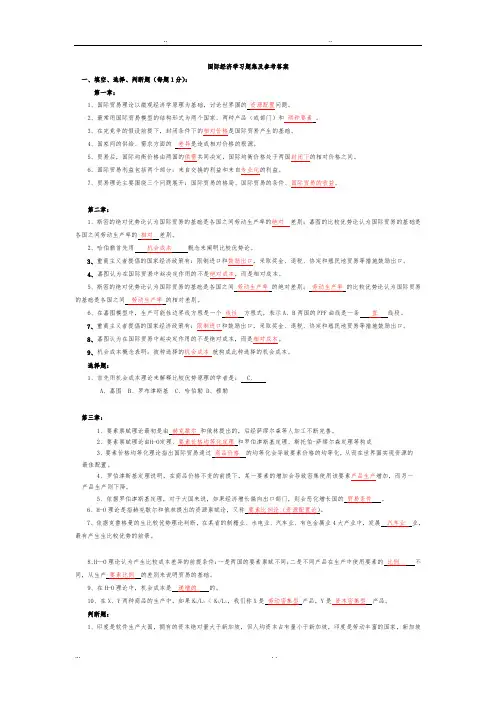
国际经济学习题集及参考答案一、填空、选择、判断题(每题1分):第一章:1、国际贸易理论以微观经济学原理为基础,讨论世界围的资源配置问题。
2、最常用国际贸易模型的结构形式为两个国家、两种产品(或部门)和两种要素。
3、在完竞争的假设前提下,封闭条件下的相对价格是国际贸易产生的基础。
4、国家间的供给、需求方面的差异是造成相对价格的根源。
5、贸易后,国际均衡价格由两国的供需共同决定,国际均衡价格处于两国封闭下的相对价格之间。
6、国际贸易利益包括两个部分:来自交换的利益和来自专业化的利益。
7、贸易理论主要围绕三个问题展开:国际贸易的格局、国际贸易的条件、国际贸易的收益。
第二章:1、斯密的绝对优势论认为国际贸易的基础是各国之间劳动生产率的绝对差别;嘉图的比较优势论认为国际贸易的基础是各国之间劳动生产率的相对差别。
2、哈伯勒首先用机会成本概念来阐明比较优势论。
3、重商主义者提倡的国家经济政策有:限制进口和鼓励出口,采取奖金、退税、协定和殖民地贸易等措施鼓励出口。
4、嘉图认为在国际贸易中起决定作用的不是绝对成本,而是相对成本。
5、斯密的绝对优势论认为国际贸易的基础是各国之间劳动生产率的绝对差别;劳动生产率的比较优势论认为国际贸易的基础是各国之间劳动生产率的相对差别。
6、在嘉图模型中,生产可能性边界线方程是一个线性方程式,表示A、B两国的PPF曲线是一条直线段。
7、重商主义者提倡的国家经济政策有:限制进口和鼓励出口,采取奖金、退税、协定和殖民地贸易等措施鼓励出口。
8、嘉图认为在国际贸易中起决定作用的不是绝对成本,而是相对成本。
9、机会成本概念表明:彼种选择的机会成本就构成此种选择的机会成本。
选择题:1、首先用机会成本理论来解释比较优势原理的学者是: C、A、嘉图B、罗布津斯基C、哈伯勒D、穆勒第三章:1、要素禀赋理论最初是由赫克歇尔和俄林提出的,后经萨缪尔森等人加工不断完善。
2、要素禀赋理论由H-O定理、要素价格均等化定理和罗伯津斯基定理、斯托伯-萨缪尔森定理等构成3、要素价格均等化理论指出国际贸易通过商品价格的均等化会导致要素价格的均等化,从而在世界围实现资源的最佳配置。
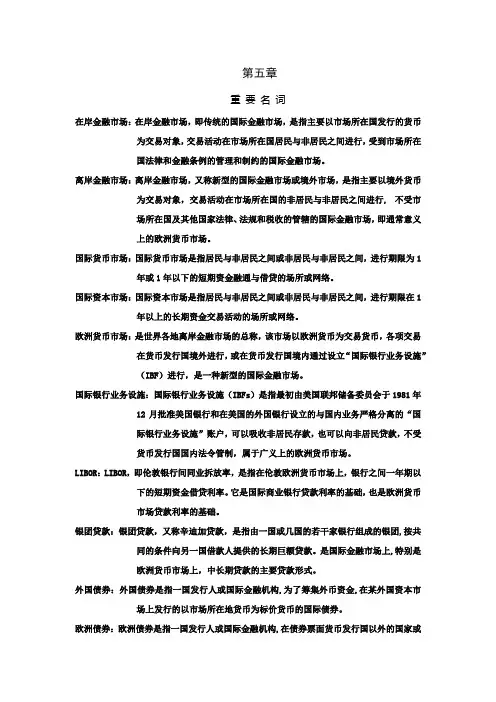
第五章重要名词在岸金融市场:在岸金融市场,即传统的国际金融市场,是指主要以市场所在国发行的货币为交易对象,交易活动在市场所在国居民与非居民之间进行,受到市场所在国法律和金融条例的管理和制约的国际金融市场。
离岸金融市场:离岸金融市场,又称新型的国际金融市场或境外市场,是指主要以境外货币为交易对象,交易活动在市场所在国的非居民与非居民之间进行, 不受市场所在国及其他国家法律、法规和税收的管辖的国际金融市场,即通常意义上的欧洲货币市场。
国际货币市场:国际货币市场是指居民与非居民之间或非居民与非居民之间,进行期限为1年或1年以下的短期资金融通与借贷的场所或网络。
国际资本市场:国际资本市场是指居民与非居民之间或非居民与非居民之间,进行期限在1年以上的长期资金交易活动的场所或网络。
欧洲货币市场:是世界各地离岸金融市场的总称,该市场以欧洲货币为交易货币,各项交易在货币发行国境外进行,或在货币发行国境内通过设立“国际银行业务设施”(IBF)进行,是一种新型的国际金融市场。
国际银行业务设施:国际银行业务设施(IBFs)是指最初由美国联邦储备委员会于1981年12月批准美国银行和在美国的外国银行设立的与国内业务严格分离的“国际银行业务设施”账户,可以吸收非居民存款,也可以向非居民贷款,不受货币发行国国内法令管制,属于广义上的欧洲货币市场。
LIBOR:LIBOR,即伦敦银行间同业拆放率,是指在伦敦欧洲货币市场上,银行之间一年期以下的短期资金借贷利率。
它是国际商业银行贷款利率的基础,也是欧洲货币市场贷款利率的基础。
银团贷款:银团贷款,又称辛迪加贷款,是指由一国或几国的若干家银行组成的银团,按共同的条件向另一国借款人提供的长期巨额贷款。
是国际金融市场上,特别是欧洲货币市场上,中长期贷款的主要贷款形式。
外国债券:外国债券是指一国发行人或国际金融机构,为了筹集外币资金,在某外国资本市场上发行的以市场所在地货币为标价货币的国际债券。
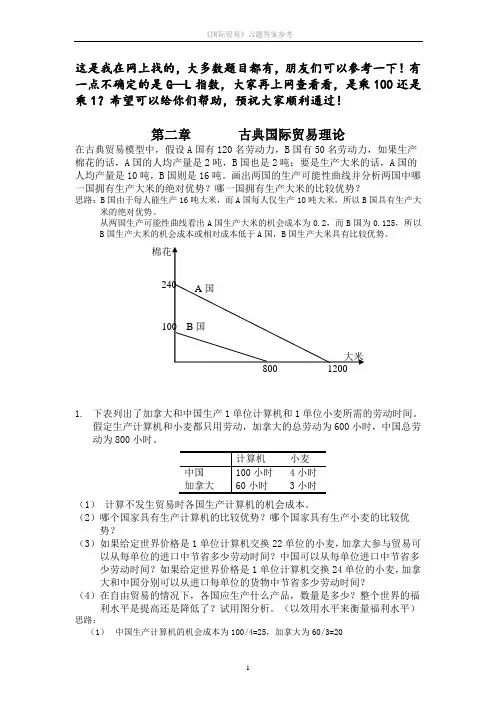
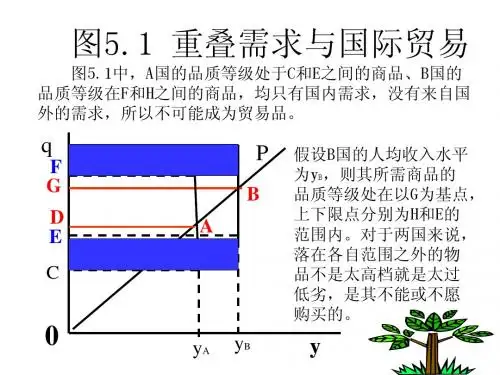
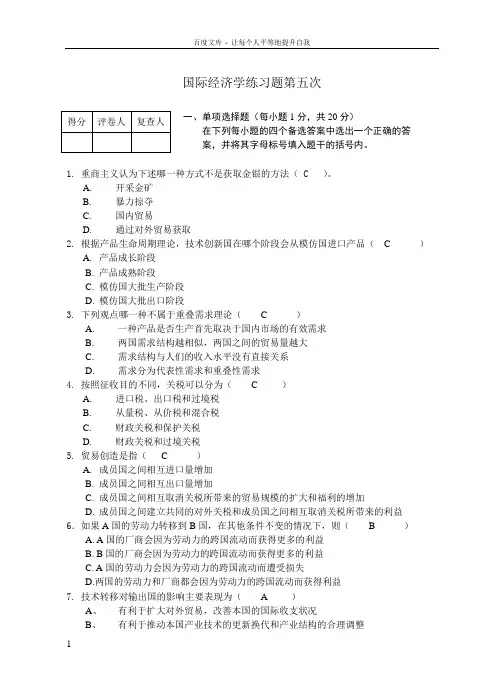
国际经济学练习题第五次1. 重商主义认为下述哪一种方式不是获取金银的方法( C )。
A. 开采金矿B. 暴力掠夺C. 国内贸易D. 通过对外贸易获取2. 根据产品生命周期理论,技术创新国在哪个阶段会从模仿国进口产品( C) A. 产品成长阶段B. 产品成熟阶段C. 模仿国大批生产阶段D. 模仿国大批出口阶段3. 下列观点哪一种不属于重叠需求理论( C )A. 一种产品是否生产首先取决于国内市场的有效需求B. 两国需求结构越相似,两国之间的贸易量越大C. 需求结构与人们的收入水平没有直接关系D. 需求分为代表性需求和重叠性需求4. 按照征收目的不同,关税可以分为( C )A. 进口税、出口税和过境税B. 从量税、从价税和混合税C. 财政关税和保护关税D. 财政关税和过境关税5. 贸易创造是指( C )A. 成员国之间相互进口量增加B. 成员国之间相互出口量增加C. 成员国之间相互取消关税所带来的贸易规模的扩大和福利的增加D. 成员国之间建立共同的对外关税和成员国之间相互取消关税所带来的利益6.如果A 国的劳动力转移到B 国,在其他条件不变的情况下,则( B )A. A 国的厂商会因为劳动力的跨国流动而获得更多的利益B. B 国的厂商会因为劳动力的跨国流动而获得更多的利益C. A 国的劳动力会因为劳动力的跨国流动而遭受损失D.两国的劳动力和厂商都会因为劳动力的跨国流动而获得利益7. 技术转移对输出国的影响主要表现为( A )A 、 有利于扩大对外贸易,改善本国的国际收支状况B 、 有利于推动本国产业技术的更新换代和产业结构的合理调整一、单项选择题(每小题1分,共20分)在下列每小题的四个备选答案中选出一个正确的答案,并将其字母标号填入题干的括号内。
C、有利于技术创新能力的提高D、可以大量节省研发费用,促进科技创新8.同国内投资相比,国际投资的主要特点为( D )A、国际投资货币单位和货币体制的差异性B、国际投资领域的市场分割及不完全竞争性C、国际投资目的的单一性D、投资环境的供给差异9.根据李斯特的观点,对于幼稚工业的保护不应该超过()A、30年B、15年C、20年D、10年10.重商主义的基本观点是( A )A、世界资源是有限的、一定的、国家的最主要目标是利用一切方法增强国家实力B、国际市场是资本主义国家可以自由利用的市场C、增加财富的最好手段就是促使各国的市场开放,从而达到贸易自由化D、增加财富的主要手段是国际贸易,因而贸易自由化是资本注意国家应该采取的最好对外贸易政策11. 要素丰裕度是指( B )A、产品生产中某种要素投入的比例大小B、一国拥有经济资源的相对丰富程度C、资本密集型产品D、劳动密集型产业12.下列哪种方式不属于进口配额的发放方式( B )A、竞争性拍卖B、按照过去的发放数额发放C、按申请程序发放D、按固定比例优惠发放13.下述哪一个不属于不公平竞争的范畴( D )A、低价倾销B、出口补贴C、污染环境D、采用先进技术占有国外市场14.贸易转移是指( D )A、成员国之间的进口量减小B、成员国之间的出口量减小C、成员国之间相互取消关税所带来的贸易规模的扩大和福利的增加D、成员国之间建立共同的对外关税和成员国之间相互取消关税所带来的贸易方向的转移15.下述哪一个不属于关税同盟的其他静态动态效应( C )A.减少行政开支B.改善贸易条件C.有利于扩大成员国、非成员国的投资D.减少走私16. 劳动力跨国流动的主要原因为( C )A. 自然资源的不均衡,促使劳动力从自然资源相对比较匮乏的地区流向自然资源比较丰富的地区B. 所有国家都普遍鼓励劳动力流入C. 劳动力总量、结构以及供求的不均衡,导致劳动力价格的不均衡,进而引起劳动力在国际范围流动D. 经济增长比较快的国家对劳动力的需求引发了劳动力的流动17. 超保护贸易理论的创始人是( A )A. 凯恩斯B. 休谟C. 蒙代尔D. 克鲁格曼18. IS曲线的左侧代表( B )A.失业B.通货膨胀C.贸易逆差D.贸易顺差19. 如果一国的经济同时存在失业和贸易逆差,其可以采用的政策措施为( C )A.财政扩张和货币扩张B.财政紧缩和货币紧缩C.财政扩张和货币紧缩D.财政紧缩和货币扩张20. 根据蒙代尔—弗莱明模型,对于实行浮动汇率制度且资本市场完全开放的小国来说,财政政策是( B )A.最有效的B.完全无效的依赖于货币政策的二、填空题(每小题1分,共10分)21.总供给是指一个经济在其生产能力和生产成本既定时,所有厂商在一定价格水平下意欲生产和销售的产品和劳务的总量曲线的右侧代表国际收支赤字23.在固定汇率下,当资本完全流动时,采用货币政策调节国际收支对本国国民收入产生影响被证明是无效的24.在浮动汇率和资本完全移动的条件下,财政政策完全无效25.在浮动汇率下,当资本不完全流动时政府扩张性财政政策一般会提高收入和利率26.经济危机一般包括繁荣、危机、萧条和复苏四个阶段27.发展中国家在战后先后采用了鼓励初级产品出口,进口替代和出口替代三种贸易政策28. 关税同盟的效果如何必须考虑静态和动态两方面效应。
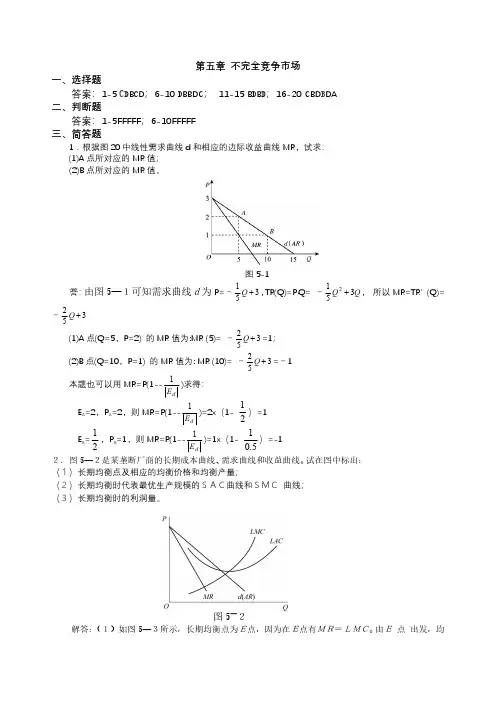
第五章不完全竞争市场一、选择题答案:1-5C D B C D ;6-10D BBDC ;11-15B D B D ;16-20CBD B DA 二、判断题答案:1-5FFFFF;6-10FFFFF 三、简答题1.根据图20中线性需求曲线d 和相应的边际收益曲线MR,试求:(1)A 点所对应的MR 值;(2)B 点所对应的MR 值。
图5-1答:由图5—1可知需求曲线d为P=-351+Q ,TR(Q)=P·Q=-Q Q 3512+,所以MR=TR′(Q)=-352+Q (1)A 点(Q=5,P=2)的MR 值为:MR (5)=-352+Q =1;(2)B 点(Q=10,P=1)的MR 值为:MR (10)=-352+Q =-1本题也可以用MR=P(1--dE 1)求得:E A =2,P A =2,则MR=P(1--dE 1)=2x(1-12)=1E B =12,P B =1,则MR=P(1--d E 1)=1x(1-10.5)=-12.图5—2是某垄断厂商的长期成本曲线、需求曲线和收益曲线。
试在图中标出:(1)长期均衡点及相应的均衡价格和均衡产量;(2)长期均衡时代表最优生产规模的SAC曲线和SMC曲线;(3)长期均衡时的利润量。
图5—2解答:(1)如图5—3所示,长期均衡点为E点,因为在E点有MR=LMC。
由E点出发,均衡价格为P0,均衡数量为Q0。
(2)长期均衡时代表最优生产规模的SAC曲线和SMC曲线如图7—3所示。
在Q0的产量上,SAC曲线和LAC曲线相切;SMC曲线和LMC曲线相交,且同时与MR曲线相交。
(3)长期均衡时的利润量由图5—3中阴影部分的面积表示,即:π=[AR (Q 0)-SAC (Q 0)]·Q 。
图5—3四、计算题(共20分)1.某垄断厂商的短期总成本函数为STC=0.1Q3—6Q2+140Q+3000,反需求函数为P=150—3.25Q,求该垄断厂商的短期均衡产量和均衡价格。
第五章作业内容1、假设挪威与瑞典相互贸易,挪威出口鱼,而瑞典出口沃尔沃汽车。
假定两国的消费偏好相同,但是生产可能性边界不同:挪威由于有较长的沿大西洋的海岸线,因此捕鱼效率高;瑞典的资本相对丰裕,故而汽车的生产效率高。
据此,根据标准贸易模型论述这两国的贸易利益。
2、在第一个问题的贸易情景中,由于过度捕鱼,挪威现在捕获的鱼量低于前些年。
这一变化不仅引起了挪威潜在产鱼数量的减少,而且导致了国际市场上鱼的相对价格的上涨。
a. 分析过度捕鱼导致挪威福利的下降。
b. 如果过度捕鱼可以提高挪威的福利水平,这将是如何实现的呢?3、在某些情况下,相对供给和价格的变动之间可能没有联系。
例如:如果生产要素在部门之间完全不可流动,生产可能性边界就会成为直角形状,两种产品的产出也不取决于它们的相对价格。
在这种情况下,贸易条件的改善是否会提高一国的福利水平请画图进行分析。
4、与供给方面要素不可流动性相当的就是需求方面的产品不可替代性。
试想一个国家的消费者购买的产品的比例是固定的。
例如,不论两种产品的相对价格是多少,每买1磅粮食就买1码棉布。
画图分析贸易条件的改善是否会提高这个国家的福利水平。
5、日本原本出口制造品进口原材料如石油、粮食。
分析以下情况日本贸易条件的变化。
a、中东战争使石油供应紧缺;b、韩国扩展了汽车的生产能力,并在美国和加拿大进行销售;c、美国的工程师建立了核反应堆以代替石油燃料发电厂;d、俄罗斯农业歉收;e、日本降低牛肉和柑橘的进口关税。
6、互联网使得诸如编程及技术支持等服务贸易增加,并且使得服务相对于制造品的价格下降。
印度尤其被认为是技术性服务的出口者,这曾经是美国的出口强项。
把制造品和服务看成可贸易品,为美印经济建立标准贸易模型,分析引起服务外包的可出口性服务的相对价格下降会降低美国的福利,而增加印度的福利。
7、A国和B国有两种生产要素——资本和劳动,用于生产两种产品——X和Y。
两国的技术水平一样,X是资本密集产品,A国是资本充裕的国家。
课后练习题答案详解第一章练习与答案为什么说在决定生产和消费时,相对价格比绝对价格更重要?答案提示:当生产处于生产边界线上,资源则得到了充分利用,这时,要想增加某一产品的生产,必须降低另一产品的生产,也就是说,增加某一产品的生产是有机会机本(或社会成本)的。
生产可能性边界上任何一点都表示生产效率和充分就业得以实现,但究竟选择哪一点,则还要看两个商品的相对价格,即它们在市场上的交换比率。
相对价格等于机会成本时,生产点在生产可能性边界上的位置也就确定了。
所以,在决定生产和消费时,相对价格比绝对价格更重要。
仿效图1—6和图1—7,试推导出Y 商品的国民供给曲线和国民需求曲线。
9* 表1 X 、Y 的单位产出所需的劳动投入A B X Y 6215 12 表2 X 、Y 的单位产出所需的劳动投入A BX Y 10 45 5答案提示:首先将劳动投入转化为劳动生产率,然后应用与本章正文中一样的方法进行比较。
(表2-2(a )和表2-2(b )部分的内容)假设A 、B 两国的生产技术条件如下所示,那么两国还有进行贸易的动机吗?解释原因。
表3 X 、Y 的单位产出所需的劳动投入A B X Y 4 2 8 4答案提示:从绝对优势来看,两国当中A 国在两种产品中都有绝对优势;从比较优势来看,两国不存在相对技术差异。
所以,两国没有进行国际贸易的动机。
证明如果一国在某一商品上具有绝对优势,那么也必具有比较优势。
——题出错了A Y X b b /〉,5个X 答案提示:封闭条件下,此国生产可能性边界的斜率是5。
因为X 的国际相对价格为2,所以此国出口X 进口Y 。
出口1,000个单位的X 可以换得2,000个单位的Y 。
贸易三角是CADA ’(见图2-5(a ))。
在图2—2(b )中,过剩供给曲线两端是否有界限?试解释原因。
答案提示:过剩供给曲线两端是有界限的,因为一国生产能力和消费需求是有界限的。
8*. 仿照图2—4,你能否画出这样一种情形:两条曲线的交点所决定的国际均衡价格与某一国封闭下的相对价格完全相同?如何解释这种结果?答案提示:从大国、小国的角度考虑。
第一章练习与答案1.为什么说在决定生产和消费时,相对价格比绝对价格更重要?答案提示:当生产处于生产边界线上,资源则得到了充分利用,这时,要想增加某一产品的生产,必须降低另一产品的生产,也就是说,增加某一产品的生产是有机会机本(或社会成本)的。
生产可能性边界上任何一点都表示生产效率和充分就业得以实现,但究竟选择哪一点,则还要看两个商品的相对价格,即它们在市场上的交换比率。
相对价格等于机会成本时,生产点在生产可能性边界上的位置也就确定了。
所以,在决定生产和消费时,相对价格比绝对价格更重要。
2.仿效图1—6和图1—7,试推导出Y商品的国民供给曲线和国民需求曲线。
答案提示:3.在只有两种商品的情况下,当一个商品达到均衡时,另外一个商品是否也同时达到均衡?试解释原因。
答案提示:4.如果生产可能性边界是一条直线,试确定过剩供给(或需求)曲线。
答案提示:5.如果改用Y商品的过剩供给曲线(B国)和过剩需求曲线(A国)来确定国际均衡价格,那么所得出的结果与图1—13中的结果是否一致?答案提示:国际均衡价格将依旧处于贸易前两国相对价格的中间某点。
6.说明贸易条件变化如何影响国际贸易利益在两国间的分配。
答案提示:一国出口产品价格的相对上升意味着此国可以用较少的出口换得较多的进口产品,有利于此国贸易利益的获得,不过,出口价格上升将不利于出口数量的增加,有损于出口国的贸易利益;与此类似,出口商品价格的下降有利于出口商品数量的增加,但是这意味着此国用较多的出口换得较少的进口产品。
对于进口国来讲,贸易条件变化对国际贸易利益的影响是相反的。
7.如果国际贸易发生在一个大国和一个小国之间,那么贸易后,国际相对价格更接近于哪一个国家在封闭下的相对价格水平?答案提示:贸易后,国际相对价格将更接近于大国在封闭下的相对价格水平。
8.根据上一题的答案,你认为哪个国家在国际贸易中福利改善程度更为明显些?答案提示:小国。
9*.为什么说两个部门要素使用比例的不同会导致生产可能性边界曲线向外凸?答案提示:第二章答案1.根据下面两个表中的数据,确定(1)贸易前的相对价格;(2)比较优势型态。
国际经济学课后习题答案这是我在网上找的,大多数题目都有,朋友们可以参考一下!有一点不确定的是G—L指数,大家再上网查看看,是乘100还是乘1希望可以给你们帮助,预祝大家顺利通过!第二章古典国际贸易理论在古典贸易模型中,假设A国有120名劳动力,B国有50名劳动力,如果生产棉花的话,A国的人均产量是2吨,B国也是2吨;要是生产大米的话,A国的人均产量是10吨,B国则是16吨。
画出两国的生产可能性曲线并分析两国中哪一国拥有生产大米的绝对优势哪一国拥有生产大米的比较优势思路:B国由于每人能生产16吨大米,而A国每人仅生产10吨大米,所以B国具有生产大米的绝对优势。
从两国生产可能性曲线看出A国生产大米的机会成本为,而B国为,所以B国生产大米的机会成本或相对成本低于A国,B国生产大米具有比较优势。
1.下表列出了加拿大和中国生产1单位计算机和1单位小麦所需的劳动时间。
假定生产计算机和小麦都只用劳动,加拿大的总劳动为600小时,中国总劳动为800小时。
(1)计算不发生贸易时各国生产计算机的机会成本。
(2)哪个国家具有生产计算机的比较优势哪个国家具有生产小麦的比较优势(3)如果给定世界价格是1单位计算机交换22单位的小麦,加拿大参与贸易可以从每单位的进口中节省多少劳动时间中国可以从每单位进口中节省多少劳动时间如果给定世界价格是1单位计算机交换24单位的小麦,加拿大和中国分别可以从进口每单位的货物中节省多少劳动时间(4)在自由贸易的情况下,各国应生产什么产品,数量是多少整个世界的福利水平是提高还是降低了试用图分析。
(以效用水平来衡量福利水平)思路:(1)中国生产计算机的机会成本为100/4=25,加拿大为60/3=20(2)因为加拿大生产计算机的机会成本比中国低,所以加拿大具有生产者计算机的比较优势,中国就具有生产小麦的比较优势。
(3)如果各国按照比较优势生产和出口,加拿大进口小麦出口计算机,中国进口计算机出口小麦。
第一章练习与答案1.为什么说在决定生产和消费时,相对价格比绝对价格更重要?答案提示:当生产处于生产边界线上,资源则得到了充分利用,这时,要想增加某一产品的生产,必须降低另一产品的生产,也就是说,增加某一产品的生产是有机会机本(或社会成本)的。
生产可能性边界上任何一点都表示生产效率和充分就业得以实现,但究竟选择哪一点,则还要看两个商品的相对价格,即它们在市场上的交换比率。
相对价格等于机会成本时,生产点在生产可能性边界上的位置也就确定了。
所以,在决定生产和消费时,相对价格比绝对价格更重要。
2.仿效图1—6和图1—7,试推导出Y商品的国民供给曲线和国民需求曲线。
答案提示:3.在只有两种商品的情况下,当一个商品达到均衡时,另外一个商品是否也同时达到均衡?试解释原因。
答案提示:4.如果生产可能性边界是一条直线,试确定过剩供给(或需求)曲线。
答案提示:5.如果改用Y商品的过剩供给曲线(B国)和过剩需求曲线(A国)来确定国际均衡价格,那么所得出的结果与图1—13中的结果是否一致?答案提示:国际均衡价格将依旧处于贸易前两国相对价格的中间某点。
6.说明贸易条件变化如何影响国际贸易利益在两国间的分配。
答案提示:一国出口产品价格的相对上升意味着此国可以用较少的出口换得较多的进口产品,有利于此国贸易利益的获得,不过,出口价格上升将不利于出口数量的增加,有损于出口国的贸易利益;与此类似,出口商品价格的下降有利于出口商品数量的增加,但是这意味着此国用较多的出口换得较少的进口产品。
对于进口国来讲,贸易条件变化对国际贸易利益的影响是相反的。
7.如果国际贸易发生在一个大国和一个小国之间,那么贸易后,国际相对价格更接近于哪一个国家在封闭下的相对价格水平?答案提示:贸易后,国际相对价格将更接近于大国在封闭下的相对价格水平。
8.根据上一题的答案,你认为哪个国家在国际贸易中福利改善程度更为明显些?答案提示:小国。
9*.为什么说两个部门要素使用比例的不同会导致生产可能性边界曲线向外凸?答案提示:第二章答案1.根据下面两个表中的数据,确定(1)贸易前的相对价格;(2)比较优势型态。
第一章练习与答案1.为什么说在决定生产和消费时,相对价格比绝对价格更重要?答案提示:当生产处于生产边界线上,资源则得到了充分利用,这时,要想增加某一产品的生产,必须降低另一产品的生产,也就是说,增加某一产品的生产是有机会机本(或社会成本)的。
生产可能性边界上任何一点都表示生产效率和充分就业得以实现,但究竟选择哪一点,则还要看两个商品的相对价格,即它们在市场上的交换比率。
相对价格等于机会成本时,生产点在生产可能性边界上的位置也就确定了。
所以,在决定生产和消费时,相对价格比绝对价格更重要。
2.仿效图1—6和图1—7,试推导出Y商品的国民供给曲线和国民需求曲线。
答案提示:3.在只有两种商品的情况下,当一个商品达到均衡时,另外一个商品是否也同时达到均衡?试解释原因。
答案提示:4.如果生产可能性边界是一条直线,试确定过剩供给(或需求)曲线。
答案提示:5.如果改用Y商品的过剩供给曲线(B国)和过剩需求曲线(A国)来确定国际均衡价格,那么所得出的结果与图1—13中的结果是否一致?答案提示:国际均衡价格将依旧处于贸易前两国相对价格的中间某点。
6.说明贸易条件变化如何影响国际贸易利益在两国间的分配。
答案提示:一国出口产品价格的相对上升意味着此国可以用较少的出口换得较多的进口产品,有利于此国贸易利益的获得,不过,出口价格上升将不利于出口数量的增加,有损于出口国的贸易利益;与此类似,出口商品价格的下降有利于出口商品数量的增加,但是这意味着此国用较多的出口换得较少的进口产品。
对于进口国来讲,贸易条件变化对国际贸易利益的影响是相反的。
7.如果国际贸易发生在一个大国和一个小国之间,那么贸易后,国际相对价格更接近于哪一个国家在封闭下的相对价格水平?答案提示:贸易后,国际相对价格将更接近于大国在封闭下的相对价格水平。
8.根据上一题的答案,你认为哪个国家在国际贸易中福利改善程度更为明显些?答案提示:小国。
9*.为什么说两个部门要素使用比例的不同会导致生产可能性边界曲线向外凸?答案提示:第二章答案1.根据下面两个表中的数据,确定(1)贸易前的相对价格;(2)比较优势型态。
Chapter 5 The Standard Trade Model
Multiple Choice Questions 1. The concept “terms of trade” means (a) the amount of exports sold by a country. (b) the price conditions bargained for in international markets. (c) the price of a country’s exports divided by the price of its imports. (d) the quantities of imports received in free trade. (e) None of the above. Answer: C
2. A country cannot produce a mix of products with a higher value than where (a) the isovalue line intersects the production possibility frontier. (b) the isovalue line is tangent to the production possibility frontier. (c) the isovalue line is above the production possibility frontier. (d) the isovalue line is below the production possibility frontier. (e) the isovalue line is tangent with the indifference curve. Answer: B
3. Tastes of individuals are represented by (a) the production possibility frontier. (b) the isovalue line. (c) the indifference curve. (d) the production function. (e) None of the above. Answer: C
4. If PC/PF were to increase in the international marketplace, then (a) all countries would be better off. (b) the terms of trade of cloth exporters improve. (c) the terms of trade of food exporters improve. (d) the terms of trade of all countries improve. (e) None of the above Answer: B 精品文档 . 5. If PC/PF were to increase,
(a) the cloth exporter would increase the quantity of cloth exports. (b) the cloth exporter would increase the quantity of cloth produced. (c) the food exporter would increase the quantity of food exports. (d) Both (a) and (c). (e) None of the above. Answer: B
6. If PC/PF were to increase, (a) world relative quantity of cloth supplied and demanded would increase. (b) world relative quantity of cloth supplied and demanded would decrease. (c) world relative quantity of cloth supplied would increases. (d) world relative quantity of cloth demanded would decrease. (e) None of the above. Answer: C
7. When the production possibility frontier shifts out relatively more in one direction, we have (a) biased growth. (b) unbiased growth. (c) immiserizing growth. (d) balanced growth. (e) imbalanced growth. Answer: A
8. Export-biased growth in Country H will (a) improve the terms of trade of Country H. (b) trigger anti-bias regulations of the WTO. (c) worsen the terms of trade of Country F (the trade partner). (d) improve the terms of trade of Country F. (e) decrease economic welfare in Country H. Answer: D
9. Immiserizing growth is (a) likely to occur if the exporting country is poor. (b) likely to occur if the exporting country is rich. (c) likely to occur when terms of trade change. (d) likely to occur if relative supplies are elastic. (e) None of the above. Answer: E 精品文档
. 10. If the U.S. Agency for International Development transfers funds to poor countries in Sub-Saharan Africa, this must
(a) worsen the U.S. terms of trade. (b) improve the U.S. terms of trade. (c) worsen the terms of trade of the African aid recipients. (d) improve the terms of trade of the African aid recipients. (e) None of the above. Answer: E
11. If the poor USAID recipient countries have a higher marginal propensity to consume each and every product than does the United States, then such aid will
(a) worsen the U.S. terms of trade. (b) improve the U.S. terms of trade. (c) leave the world terms of trade unaffected. (d) worsen the terms of trade of both donor and recipient countries. (e) None of the above. Answer: B
12. If the U.S. has a higher marginal propensity to consume (MPC) imports as compared to both its MPC for exportables and nontradables, then such aid will
(a) worsen the U.S. terms of trade. (b) improve the U.S. terms of trade. (c) leave the world terms of trade unaffected. (d) worsen the terms of trade of both donor and recipient countries. (e) None of the above. Answer: B
13. If the U.S. (a large country) imposes a tariff on its imported good, this will tend to (a) have no effect on terms of trade. (b) improve the terms of trade of all countries. (c) improve the terms of trade of the United States. (d) cause a deterioration of U.S. terms of trade. (e) raise the world price of the good imported by the United States. Answer: C
14. If the U.S. (a large country) imposes a tariff on its imported good, this will (a) have no effect on economic welfare. (b) improve the terms of trade of all countries. (c) improve the economic welfare of the United States. (d) harm the economic welfare of U.S.’ trading partners. (e) None of the above Answer: D